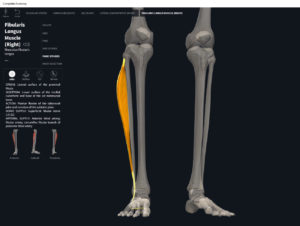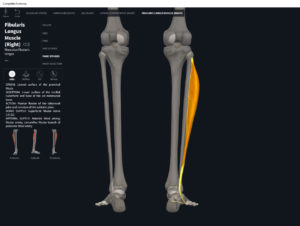Anatomy & Physiology: Muscles—Fibularis (Peroneus) Longus.
Structure.
- Origin: fibular head and body; lateral condyle of tibia.
- Insertion: metatarsal I and first cuneiform.
Function.
- Concentric action: plantar flexion; eversion.
- Reverse mover action: evert talus at subtalar joint; plantar flexion.
- Eccentric action: decelerates ankle dorsiflexion and inversion.
- Isometric action: stabilization of foot and ankle.
- Innervation: superficial fibular (peroneal) nerve.
- Arterial supply: fibular artery.
Clinical Significance.
More.
- https://www.anatomynext.com/peroneus-longus/
- https://www.youtube.com/watch?v=v_0TSoPzd3A
- https://www.youtube.com/watch?v=Ck3I82N5Gag
References
Biel, A. (2015). Trail guide to the body: A hands-on guide to locating muscles, bones and more.
Clark, M., Lucett, S., Sutton, B. G., & National Academy of Sports Medicine. (2014). NASM essentials of corrective exercise training. Burlington, MA: Jones & Bartlett Learning.
Jenkins, G., & Tortora, G. J. (2012). Anatomy and Physiology: From Science to Life, 3rd Edition International Stu. John Wiley & Sons.
Muscolino, J. E. (2017). The muscular system manual: The skeletal muscles of the human body.



